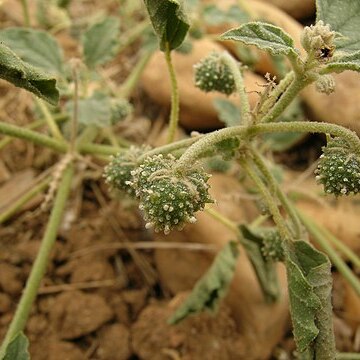Herbs or shrubs, evergreen, annual or perennial, monoecious; stems and foliage without latex. Indumentum of simple, multicellular trichomes, glandular trichomes absent, stinging trichomes absent. Stipules entire, inconspicuous, deciduous. Leaves alternate, petiolate, elobate, palmi-or penninerved, entire to crenate, glands 2 at lamina base. Inflorescences axillary or leaf-opposed [cf. subfam. description-Editor], racemose or paniculate, solitary, bisexual [?and androgynous], with flowers in bracteate clusters. Male flowers pedicellate; calyx lobes 5, valvate, partially connate; petals 5, imbricate, partially connate; disc 5-lobed; stamens 3–15, filaments connate into a central column, 1–3-seriate; anthers dorsifixed, bilobate, thecae oblong and longitudinally dehiscent; pistillodes absent. Female flowers pedicellate; calyx lobes 5, valvate, free; petals 5 or absent, valvate, free; disc 5-lobed; ovary 3-locular, ovules uniloculate; styles 3, shortly connate at base, bifid. Fruit capsular, trilobate, dehiscing septicidally into 3 bivalved cocci. Seeds ovoid to subglobose; testa crustaceous; albumen fleshy; caruncles divided, arilloid; cotyledons broad, flat.
Herbs or subshrubs; indumentum of stellate hairs and/or peltate scales, usually dense. Leaves alternate; stipules subulate; leaf blade margin entire or repand-dentate, base usually with 2 glands. Inflorescences axillary, racemelike thyrses, bisexual, male flowers distal, female flowers proximal. Male flowers: sepals 5, valvate; petals 5; disk absent, rarely present; stamens 5-15; filaments connate into a column; anthers 2-locular. Female flowers: sepals 5, valvate; petals 5, rarely absent; disk 5-glandular; ovary 3-locular; styles 3, 2-lobed, papillose. Fruit a capsule, stellate-pubescent or scaly, sometimes tuberculate, 3-locular. Seeds ovoid, smooth or warty.
Male flowers: pedicels short; calyx closed in bud, later splitting into 5 valvate lobes; petals 5, distally imbricate, lightly coherent; disk 5-lobed, the lobes alternating with the petals; stamens 3–15, filaments connate into a column, 1–3-seriate, anthers oblong, erect, longitudinally dehiscent; pistillode absent.
Female flowers: pedicels long, often further elongating and reflexing in fruit; sepals 5, open in bud; petals 5, smaller than in the male or 0; disk more or less as in the male; ovary 3-locular, with 1 ovule per loculus; styles 3, connate at the base, bifid, more or less erect.
Inflorescences pseudo-axillary, lateral or leaf-opposed, racemose or subpaniculate, male above, female below; bracts 1-flowered; female flowers on 1 or more 1–4-flowered peduncles.
Leaves alternate, petiolate, stipulate, simple, subentire, dentate or sublobate, penni-or palminerved, often plicate or bullate when young, 2-glandular at the base of the lamina.
Seeds ovoid or subglobose, tuberculate or smooth, enveloped in a thin aril, ecarunculate; albumen thick, fleshy; cotyledons broad and flat.
Fruits 3-lobed, dehiscing septicidally into 3 bivalved cocci, leaving a columella; endocarp thinly woody.
Monoecious, annual or perennial herbs or shrubs.
Indumentum stellate.

